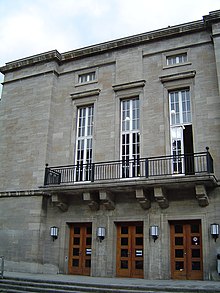Academy for Political Science and Law of the GDR
The Academy for Political Science and Law of the GDR (ASR) was a GDR institution based in the Babelsberg district of Potsdam on Griebnitzsee . It acted as an educational institution for senior employees in the state apparatus , in administration and in the diplomatic service of the GDR . It was both a scientific institution, a university with the right to award doctorates , as well as an institution for training and further education.
During its existence, not only the tasks but also their names changed. From the original German Administrative School which was German Academy of Law and Political Science (DASR) "Walter Ulbricht" , which was renamed after the death of Walter Ulbricht in 1973 in the Academy of Law and Political Science of the GDR took place (ASR). This academy should not be confused with the former university of the Ministry for State Security, also located in Potsdam, in Golm .
history
Predecessor of the furniture was in 1948 in Brandenburg Forst Zinna resulting German Academy of Public Administration , whose first director Peter Alfons Stony was. In the early years, the lawyer Götz Berger was one of the lecturers. In 1950 the academy was given the additional name Walter Ulbricht . The DVA was merged in 1953 with the German University of Justice in Potsdam-Babelsberg, which was only founded in 1952 . In 1959 the German Institute for Law was also affiliated. In 1950, the DVA opened a children's home in which mainly single students could accommodate their children for the duration of their studies, which, like the academy from Forst Zinna, moved to Potsdam in 1953 and found its home in the nearby Babelsberger Stubenrauchstrasse .
With the establishment of the academy, an institution was created that competed with the corresponding old law university faculties . It was under direct political control and, with its politicized teaching operations, was soon regarded as a quasi-party college of the SED .
In the first few years, the training of executives (cadres) deployed in their functions after 1945 was a central task. The higher education entrance qualification was not a prerequisite for taking up a two-year course, which could also be completed as a distance learning course. At the end there was a degree in political science.
Between 1953 and 1963, however, the focus was on legal training. After the introduction of the “New Economic System of Planning and Management” (NÖSPL) in 1963, the legal training ended - however, the doctorate and habilitation remained possible. After that, the further training of leading employees in the state apparatus, the training and further education of members of the diplomatic service and legal research became the task of the academy.
The facility was then directly subordinated to the GDR Council of Ministers . It was divided into three institutes.
- Institute for legal and political research
- Institute for further training of leading employees of state bodies
- Institute for International Relations
In 1965, the DASR handed over the existing children's home to the city of Potsdam, which continued to operate it until 1993 and then transferred it to the “Eva Laube” child and youth welfare association, an institution of the Protestant youth and welfare organization .
In the course of the restructuring of the education system, the tasks of the academy were expanded through an "academy reform". It became the central research institution in the field of law and political science . This priority role ended in 1973 with the establishment of political and legal institutions at the Academy of Sciences of the GDR . In connection with the changes in higher education in the GDR, the academy was also restructured. It was divided into four sections:
- Theory of the socialist state and its law
- scientific foundations of the overall system of socialist state leadership
- socialist administration of justice
- Legal questions of the central planning and management of the socialist national economy by the state.
Structure in the 1980s
This alignment with the structures of the universities was later abandoned. In the 1980s there were three sections ( Marxism-Leninism , Constitutional Law and State Management, Criminal, Civil, Labor and Agricultural Law) as well as four institutes (International Relations, State and Legal Theory, Foreign Law and Comparative Law, Administrative Organization and Office Technology) .
As part of their further training, the leading employees of the state apparatus should take part in a one-month course every two years. A two-year course prepared for taking on a leading position. In addition, the academy recently offered a four-year university course. A part-time distance learning course was also possible.
The academy had a large special library with 350,000 volumes. Like an information and computer center, this was also available to the state institutions for the procurement of state law information.
After German reunification at the end of 1990, it was wound up under the name "University of Law and Administration". In 1991, two sections became part of the Law Faculty of the Brandenburg State University .
The main building in Babelsberg Park at Griebnitzsee was demolished in 2008.
Rectors
- Hermann Kleyer (1952–1955)
- Herbert Kröger (1955–1964)
- Rainer Arlt (1966–1972)
- Gerhard Schüßler (1972–1984)
- Horst Steeger (1984–1990)
literature
- GDR manual vol. 1 A – L. Cologne, 1985 p. 36f.
See also
Web links
Individual evidence
- ^ With new working methods to new successes in: New Germany daily newspaper of May 5, 1950. Page 4
- ↑ Ralph Jessen: Academic Elite and Communist Dictatorship. The East German university teaching staff in the Ulbricht era , Göttingen 1999, p. 137
- ↑ Publication of the Diakonie: Potsdam children's home "Eva Laube" celebrates its 60th anniversary ( Memento from August 11, 2013 in the Internet Archive )
- ↑ https://www.uni-potsdam.de/de/zeitzeichen/standorte/griebnitzsee/die-akademie-fuer-staats-und-rechtswwissenschaft.html
- ↑ Grass grows through the GDR Academy at neue-deutschland.de. Retrieved March 10, 2020.
Coordinates: 52 ° 24 '21.7 " N , 13 ° 5' 51.3" E
